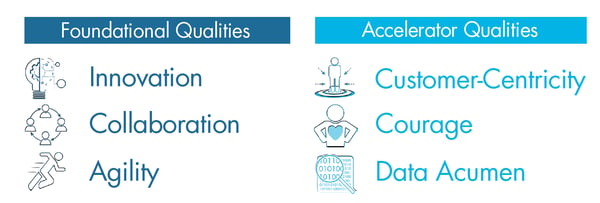The advent and duration of the COVID-19 pandemic and the resulting need for many people to work remotely has accelerated the use of new, fast and frequently changing digital technology to solve business problems. Whether it has been the use of ever advancing technology like ZOOMSM or Microsoft® TEAMS or the fast-tracking of more complex technological processes like Telehealth, businesses are radically re-thinking how they are using technology, people and processes to survive and thrive in the current economy.
One of the major side effects of the pandemic has been the need for many organizations to speed up their digital transformation efforts. Changing customer and consumer engagement needs resulted in greater focus on online retail, faster implementation of technology within the manufacturing supply chain, creation of virtual events, on demand food service developments, data optimization, and many other changes.
 Interestingly, some leaders are surprised by how fast and effectively digital transformation has gained traction in their organization. Of course, a much more urgent case for change and speed exists now. But, companies have been able to adopt new technology, create new processes, and develop new employee behaviors that are yielding targeted results. Before Covid-19, these transformations were perceived as major change efforts with daunting project implementation plans. But now, we’ve managed to execute quickly developed plans to meet current customer demands, and, for the most part, it’s working and that’s a reason to celebrate.
Interestingly, some leaders are surprised by how fast and effectively digital transformation has gained traction in their organization. Of course, a much more urgent case for change and speed exists now. But, companies have been able to adopt new technology, create new processes, and develop new employee behaviors that are yielding targeted results. Before Covid-19, these transformations were perceived as major change efforts with daunting project implementation plans. But now, we’ve managed to execute quickly developed plans to meet current customer demands, and, for the most part, it’s working and that’s a reason to celebrate.
How to Leverage the Momentum Gained
On the flip side, if organizations look at this short-term accomplishment as a once-and-done initiative, the positive impacts of what has changed may not last. Digital transformation requires a sustained culture shift that doesn’t come about in just a few weeks.
What can you do to continue to build on the momentum you have gained?
- You can start with ensuring that leaders at all levels know what you want your digital culture to look like for maximum engagement, adoption and growth. Our research and experience show there are six qualities required to build a digital culture. They are:
 The first three qualities are foundational qualities and must be present throughout the transformation. The next three qualities are required to accelerate and sustain the transformation.
The first three qualities are foundational qualities and must be present throughout the transformation. The next three qualities are required to accelerate and sustain the transformation. - Next, determine what behaviors you as a leader need to demonstrate to firmly entrench these six qualities in your digital culture. For example, encouraging curiosity and being open to new thinking and ideas kickstarts innovation. Providing clear direction and motivation leads employee teams to agilely adopt the new ways of work that come with digital transformations.
Additionally, think about the behaviors you need from your employees to bring these qualities to life. Helping them engage with your customers through technology in an empathetic way to personalize their experience will increase your customer-centricity. Encouraging employees to build cross-functional relationships and share relevant data, will establish a culture of collaboration. - Don’t forget to monitor data and celebrate success, course correct when necessary, and be on the lookout for barriers that may impede success. Engage others when necessary to help remove barriers.
How will you know that you are successful in each of the above?
- Leaders and the organization are aligned around why creating and sustaining a digital culture is important and our goals.
- Leaders are bringing about the personal and organizational behavior change necessary for the digital culture to become “the new way we do business.”
- Targeted results are being achieved.
- “The new way we do business” becomes “just the way we do business.
The bottom-line: Digital transformation is an ongoing, organization-wide process. It’s also a significant change that, if successful, is leader-led and part of how you “do business” every day.
One final tip, don’t underestimate the impact of your culture. Invest as much time and effort on driving the execution of your digital culture as you do on the digital strategy and technology selection.
You may also be interested in Key Elements for Executing a Digital Transformation Strategy.

















Conversation